BREEDING
Pig Rearing
At puberty, weight should be considered in pigs. With good nutrition, pig can attain maturity with 60-70 kgs weight in 7-8 months of age.
Age at Puberty
Boars: boars reach sexual maturity at 6-8 months of age, but they must be at least 10-12 months (100 kg) before being put to breeding.
Gilt: puberty occurs at 5-7 months of age, but they are put for breeding only after 8-10 months at about 80-100 kg live weight.
Heat Signs
Boars: Includes phases of courtship, mounting, intromission and ejection. The duration of copulation is 3 to 20 minutes.
Gilt/ Sow: External signs are restlessness, grunting, champing of jaws, swollen and reddened vulva, vaginal discharge, allowing mounting by other animals, frequent mounting on other animals, frequent urination and standing heat reflux.
Reduced Feeding
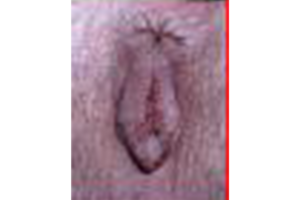

‘Standing heat reflux’ is immobilization, arching back and in some breeds the cocking of the ears. This reflux is normally exhibited in the presence of boars, but may also elicited by applying downward pressure on the back of animal called ‘riding or back pressure test’. Also called “wooden horse posture”
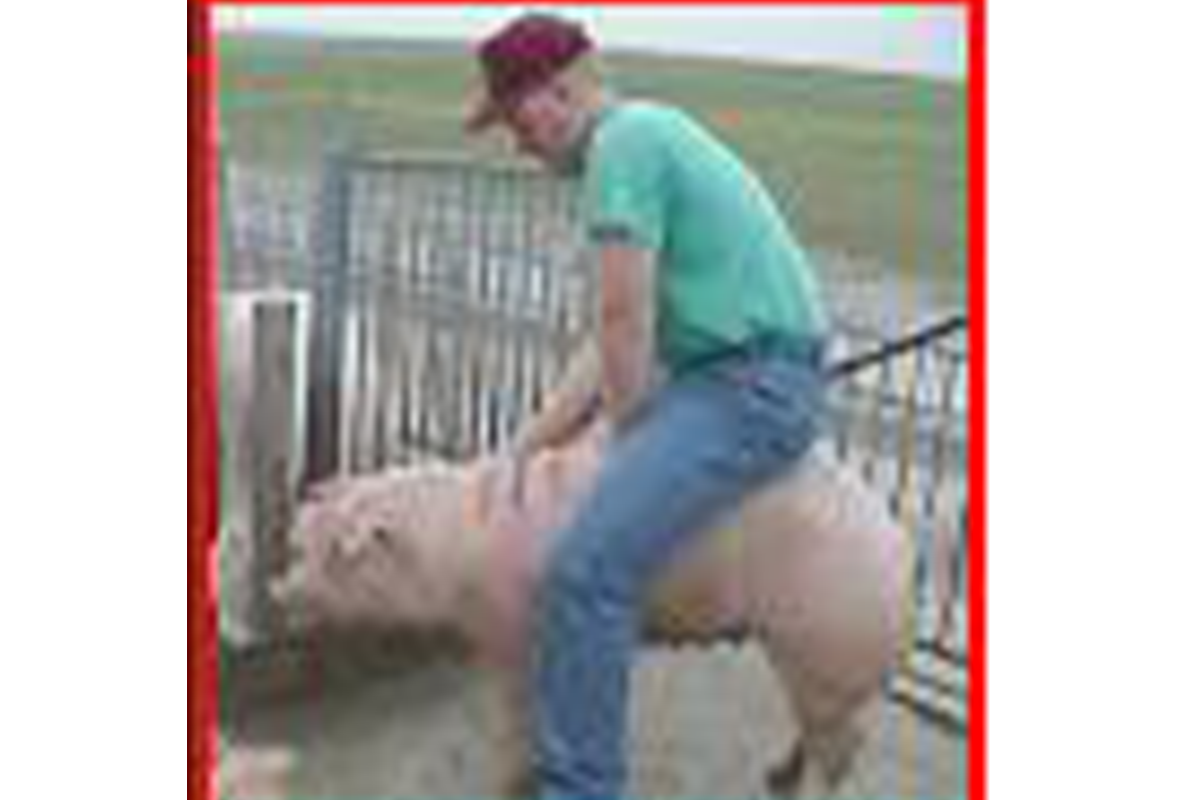
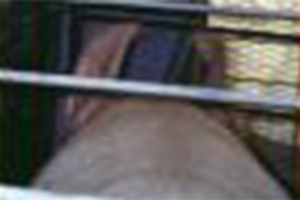
The attainment of estrus occurs once every 19-23 days and may last for a period of 3-4 days.
Time of Mating
Usually done 24 hrs after onset of heat symptoms, a second mating is advised after 8-12 hrs after the first mating. Gilts are bred at least twice at 12 hrs interval and sows at least at 24 hr interval after standing heat is observed.
Mating systems
Hand mating: The sow is brought to the individual boar for service in boar sty. This is most common method in pure breeds and farrowing rate is more accurate
Pen mating: one boar is allowed to a group of sows (8-10) for detecting heat and mating.
Flock mating: boar is permitted to run with the herd. Mature boar can usually satisfactorily serve 15- 20 sows.
Artificial insemination: It allows genetic improvement and disease control. Hotter climates are least suitable to A.I operations.
ARTIFICIAL INSEMINATION (AI) IN PIGS
Artificial insemination process in pigs
When using semen collected on-farm or buying it from an artificial insemination (AI) centre, successful insemination depends on:
- detecting oestrus in sows
- insemination timing
- correct technique
- storing and handling semen correctly.
Detecting oestrus
During a sow’s 50–60 hour oestrus or heat period, she will mate but she is only very fertile for 24–32 hours.
Familiarity with signs during proestrus, oestrus and peak fertility ensures that insemination can occur during the best possible time frame.
Timing
The timing of insemination of sows is central to success in an artificial insemination breeding program.
Sperm and eggs are viable for only a limited period of time, so to achieve the best results perform inseminations within these time limits.
Detecting the oestrus cycle is critical to timing of insemination. Briefly, insemination of the sow should occur twice. Once between 8 and 12 hours after the handler first gets the standing reaction and again 8–16 hours later.
If inseminating only once, it should be done 24–32 hours after the onset of standing heat. In practice, this insemination can be performed when checking for standing heat (twice daily). Inseminate about 24 hours after the sow stands to back pressure.
Technique
Using the correct insemination technique increases your chances of success. The technique should imitate natural mating as closely as possible. For CAI (Cervical Artificial Insemination) cleaning the area around the sow’s vulva, manually stimulating the sow in the presence of a boar to induce the mating stance and careful insertion of the catheter will help to obtain a positive outcome.
When using the PCAI (Post Cervical Artificial Insemination) method the sow should be stimulated by a mature boar and then allowed to relax for 30 minutes before insemination procedures commence. The vulva should be cleaned to ensure particles and micro-organisms are not passed into the uterine body. Boar stimulation during insemination is not required.
Storing and handling semen
Use the correct equipment and take care of equipment when collecting boar semen
AI success can be compromised by poor quality semen, due to:
- rough handling
- temperature changes
- delays in transport
- exposure to light.
Tips for success
- When handling the sow, be firm but not aggressive.
- Ensure staff are trained in the movement and handling of pigs.
- If a sow or gilt first stands to back pressure in the morning when near a boar, inseminate late in the afternoon of the same day and again the following morning.
- If a sow or gilt stands in the afternoon, inseminate her the following morning and again late that afternoon.
- If only doing a single insemination, it should be done 24–32 hours after the onset of standing heat.
- If mucous is present, it should be creamy in color rather than clear. If it is clear, it is too early to inseminate.
- Use clean equipment for every insemination and ensure the sow is adequately stimulated before insemination.
- Carefully insert the catheter with spiral tips that lock in (like the boar’s penis) and reduce back-flow during insemination and be patient and allow the semen to flow slowly.
- When using the CAI (Cervical AI) method, continue stimulating the sow during insemination and continue to handle the sow firmly but not aggressively.
- When using the PCAI (Post-Cervical AI) method allow the sow to relax for 30 minutes after interaction with the spotter boar before commencing the insemination procedure.
- Be alert for catheter blockages and semen back-flow.
- Record date and time of actions plus identity of inseminator for future reference.
Advantages and disadvantages of artificial insemination in pigs
Advantages
- Superior sire line genetics (i.e. the genetic influence of good boars) can be spread more widely across the herd.
- Compared with bringing in live pigs, AI is a safe, and cost-effective method of introducing new genes into pig herds
- It may be used during temporary shortages of boars due to death, lameness or refusal to work decreases the number of boars in the herd that are fit for service.
Disadvantages
- Semen is temperature sensitive and lower than average results can occur when chilled semen is stored for longer than 72 hours.
- Disappointing results can occur when AI is poorly timed or performed incorrectly due to operator fatigue.
- Delays in the transport of semen between the collection centre and the pig breeding facility will have an adverse effect on success rate.
A.I makes it possible to breed at least 10 or more sows in one day from one ejaculate.
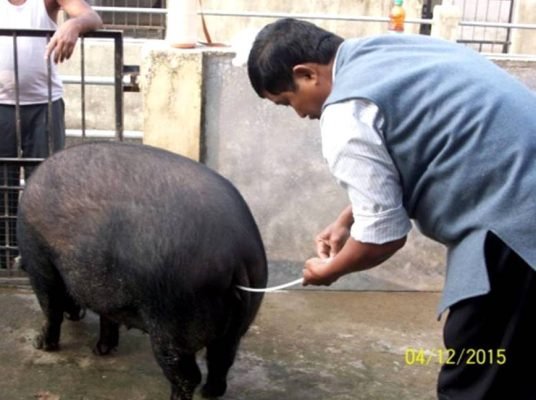
AI in pigs
Norms for Normal Swine Production
| Age at puberty (boars) | 6-8 months |
| Age at puberty (gilts) | 5-7 months |
| Breeding age of boars | 1-1.5 years |
| Breeding age for gilts | 8-10 months |
| Sex ratio | 1:20 |
| Oestrus cycle | 18-24 days |
| Oestrus period | 2-3 days |
| Apt time for mating | 24 hours after onset of heat signs and second mating is advised at 8-12 hours after first mating |
| Gestation period | 114 days (3 months, 3weeks, 3 days) |
| Weaning age | 56 days |
| Average litter size | 8-12 |
| Birth weight | 1.2-1.3kg |
| Weaning weight | 12-13kg |
| Volume of ejaculate | 200ml |
| Market age of fattening pigs | 7-9 months |
| Weight at six months | 70-75 kg |
| Market weight | 100-120 kg |
| Average life of sow | Up to 6 litters |
Source: Livestock Production Management, NSR Sastry and CK Thomas
SWINE BREEDING POLICY
National Guidelines for formulation of State Pig Breeding Policy
The National Guidelines for formulation of State Pig Breeding Policy of Department of Animal Husbandry, Dairying & Fisheries, Government of India will focus on outline of pig-breeding needs of the country, leaving flexibility to states to work upon as per their requirement within the frame-work.
1. Objectives:
- Genetic improvement of local pigs through selective breeding
- Conserve/maintain nucleus herd of well-developed indigenous pig germ plasm.
- Genetic improvement of local/non-descript animals by crossbreeding and gradually replacing the non-descript animals with crossbred germplasm of desired level of exotic inheritance.
- Maintenance of well-developed planned crossbred animals at farmers’ field.
- Expansion and strengthening of breeding infrastructure and support mechanism to propagate elite germplasm through Artificial Insemination (AI).
- Holistic development of piggery sector in terms of breeding, feeding, management, housing, value addition and marketing. The target is to improve the integration and position of local farmers and entrepreneurs into a pig-production and marketing value chain.
2. Breeding Policy:
2.1 Recognition and Conservation of Indigenous Germplasm:
2.1.1 Cross Breeding: -
Crossbred to be propagated in different region:
- Northern India · Large White Yorkshire · Large White Yorkshire cross · Landrace cross
- Northeastern India · Hampshire cross · Large white Yorkshire specifically for Mizoram and Tripura · Triple cross with Duroc as terminal sire · Large Black cross
- Eastern India · Hampshire cross · Tamworth cross (specifically Jharkhand)
- Central India · Landrace cross · Large white Yorkshire cross
- Southern India · Large white Yorkshire cross · Triple cross with Duroc as terminal sire.
- Western India · Large white Yorkshire cross
Schematic diagram for pig breeding programme in different States
2.1.2 Breeding with Exotic Germplasm:
- Import of exotic germplasm, specifically, Hampshire, Large White Yorkshire, Duroc, Landrace and Large Black from reputed source after all bio-security checking. Preference may be given to the first three breeds for import.
- Import may be done for live animal instead of frozen semen, as the success rate of frozen semen is very low.
- Developed breed-specific nucleus herd of imported germplasm for subsequent use in crossbreeding programme.
3. Breeding plan:
3.1 Nucleus Farm:
- Nucleus farm may be of pure exotic breed, well-developed crossbred or pure indigenous breed.
- Minimum 30 breedable sows’ unit should be maintained with a sex ratio of 1:3 and thus 10 sires (2 sires from each 5 unrelated sire lines) need to be maintained by each of the unit.
- Selection of male animals should be based on weaning weight (best 25%) and 8 month body weight (best 5%), based on two stage sequential selection. Selection of female animals should be based on dam’s litter size at birth (>7) and weaning weight (best 25%) and number of functional teats (at least 6 pairs of functional teats). However, these can be changed as per performance of local crossbred animals.
- Three number of farrowing per sow need to be recorded. Three farrowing per sow should be completed in 2 years.
- Weightage of selection need to be given on litter size and weight at birth and weaning.
- Besides routine productive, reproductive, adaptive and carcass traits, lifetime production traits may also be recorded.
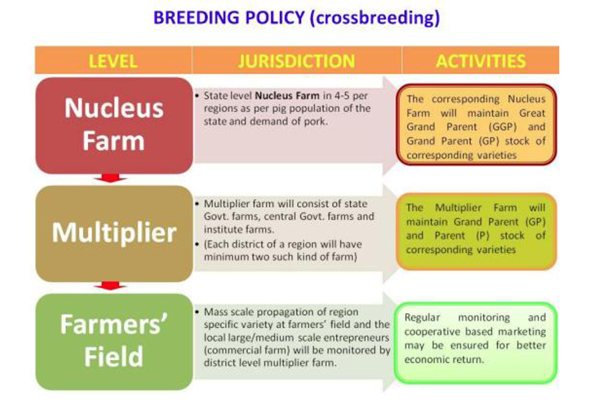
3.2 Multiplier and Farmers’ Farm:
1.Multiplier farm should maintain grandparent (GP) and parent (P) stock of desired variety. The replacement (GP and P) stock of multiplier farm should be made available from nucleus farm. Multiplier farm should produce desired animals for propagation to farmers’ field.
2. Breeding plan for farmers’ field should be separate with that of nucleus and multiplier farm. They are only to make inter-se-mating among the developed crossbred animal
3.3 Mating system:
All the breeding propagation activity should preferably follow Artificial Insemination (AI) practice. To achieve the target the State level Multiplier farm must have a training center for the local farmers including modest facility/laboratory for semen collection, evaluation and preservation. However, natural mating in some cases may also be adopted based on infrastructure of different states.
Selection of boars in breeding programme should be based on following points:
- The breeding boars require a recorded pedigree, a quality certificate for the breed issued by the authority for boars used for AI/natural mating.
- The boars used for AI must be quarterly performance tested for semen quality.
- The minimum area for keeping a breeding boar is 5m2 for the local breed and 6m2 for the exotic breed.
- The maximum frequency of use of boars is 2 times a week for AI boars younger than two years, 3 times a week for AI boars older than 2 years, and 3 times a week for natural mating boars.
- The earliest age of use for AI or natural mating is 8 months for local boars and 10 months for exotic boars.
- AI boars should not be used for more than 3.5 years, and natural mating boars for not more than 3 years.
- The reports on the quality of these boars shall be annually sent to Department of Animal Husbandry, Dairying & Fisheries (DADF) for evaluation.
- Boars needs to be vaccinated against swine fever, pasteurellosis, foot and mouth disease and other diseases as regulated.
- A certification system should be implemented step by step for better quality breeding boars and sows for organized farms which can be recognized as certified breeding animals.
3.4 Culling:
Bad/ unproductive animals should be eliminated from each generation. Animals along with its family with specific genetic disorders should be eliminated from the breeding programme.
3.5 Traceability and disease control:
A systematic process of identification, registration and recording of animals should be followed to keep track of the individual animals. Specific system should develop for pig disease surveillance and monitoring.
3.6 Capacity building:
- Training of farm managers/large scale entrepreneurs on breeding management
- Regular/refresher training for technical personnel, para-vets and livestock service provider
- Training on semen collection and AI to farmers/service provider
3.7 Infrastructure building:
- Provision may be kept for import/purchase of advanced machinery for feeding and watering.
- Development/provision of infrastructure at farmers’ field for climate resilient housing for pigs.
- Establishment of a bacon factory in the State would reduce the transportation cost by rail and boost piggery in the State.
- Value addition of pork and pork-products should be promoted for better profitability of the farmers.
- Cooperative based market chain should be developed.
- All the states should develop specific quarantine facilities for import of animals.
3.8 Subsidies and other financial support
- Easy bank credit facility
- One time subsidy for smallholders purchasing breeding boars
- Annual subsidies for using AI services
- One time subsidy for AI service providers
- One time subsidy for waste management system
- Subsidies for the import of Grand Parent and Parent stocks
- Price subsidies for indigenous pork producers
- Subsidies for infrastructure development
- Tax holiday for specific period for large scale commercial pig farms
4. Development of state specific policy and Implementation
The states having significant effect of piggery in livelihood of the population should work upon as per their requirement within the frame-work of this policy considering following facts:
- Involvement of cultural and social system of the state.
- Sectoral analysis of pig rearers of the states need to be done for formulation of specific policy with zero input, low input and intensive pig farming system.
- Formulation of state-specific breeding plan should target the defined single or multiple objectives/breeding goal.
- Tentative time span for achieving the breeding objective need to be fixed based on socio-cultural status of the states.
- State may target to encourage the entrepreneurs and private/ commercial pig farmers.
- Policies for development of state specific organic pig farms may be taken up.
- State Pig Breeding Policy will be mandatory for importing States before submission of any proposal for import of exotic breeds of pigs
- The Policy should target to improve the integration and position of local farmers and entrepreneurs into a pig-production and marketing value chain.
